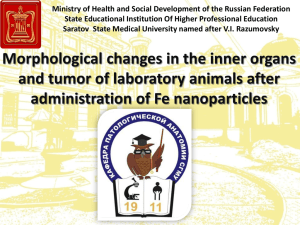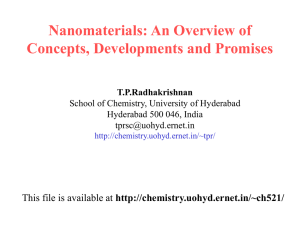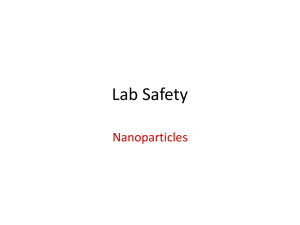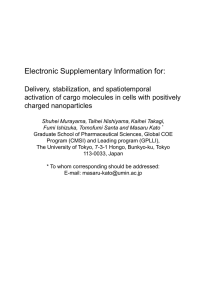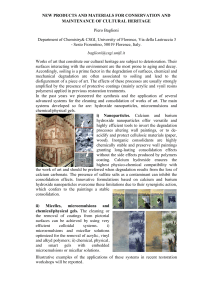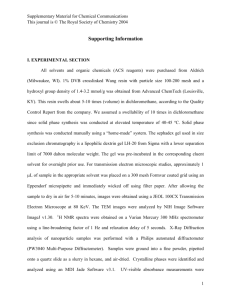Word file (1.13 MB )
advertisement
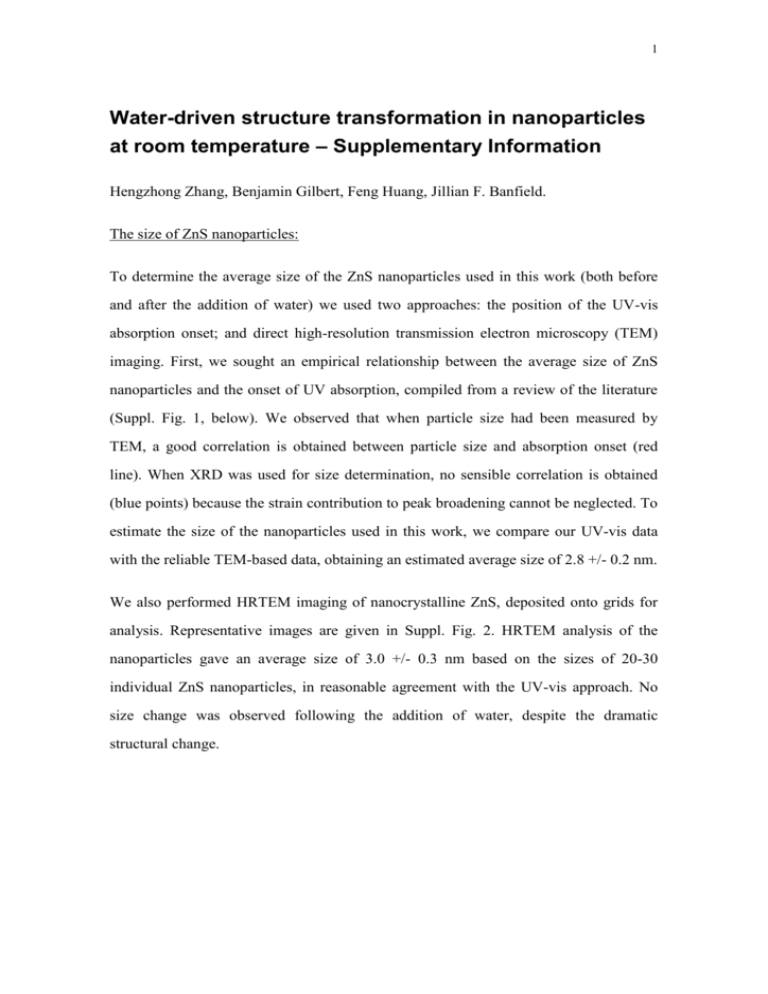
1 Water-driven structure transformation in nanoparticles at room temperature – Supplementary Information Hengzhong Zhang, Benjamin Gilbert, Feng Huang, Jillian F. Banfield. The size of ZnS nanoparticles: To determine the average size of the ZnS nanoparticles used in this work (both before and after the addition of water) we used two approaches: the position of the UV-vis absorption onset; and direct high-resolution transmission electron microscopy (TEM) imaging. First, we sought an empirical relationship between the average size of ZnS nanoparticles and the onset of UV absorption, compiled from a review of the literature (Suppl. Fig. 1, below). We observed that when particle size had been measured by TEM, a good correlation is obtained between particle size and absorption onset (red line). When XRD was used for size determination, no sensible correlation is obtained (blue points) because the strain contribution to peak broadening cannot be neglected. To estimate the size of the nanoparticles used in this work, we compare our UV-vis data with the reliable TEM-based data, obtaining an estimated average size of 2.8 +/- 0.2 nm. We also performed HRTEM imaging of nanocrystalline ZnS, deposited onto grids for analysis. Representative images are given in Suppl. Fig. 2. HRTEM analysis of the nanoparticles gave an average size of 3.0 +/- 0.3 nm based on the sizes of 20-30 individual ZnS nanoparticles, in reasonable agreement with the UV-vis approach. No size change was observed following the addition of water, despite the dramatic structural change. 2 Supplementary Figure 1. The empirical relationship between the average size of ZnS nanoparticles and the onset of UV absorption, compiled from a review of the literature (red and blue points). We digitized the UV-vis spectra from reports in the literature, choosing only those in which the full threshold regions of the UV-vis spectrum was displayed, and in which the average nanoparticle size was determined by independent means, either with TEM [refs. S1-S3] or XRD [refs. S4-S6]. We plot the point of inflection in the UV-vis spectrum vs. particle diameter, obtaining a reasonably continuous curve only when the average particle size was determined by TEM. Hence, this subset of the compiled data (dashed red line) was used to estimate the average size distribution of the ZnS nanoparticles studied in this work. The position of the absorption onset measured in this is shown as a black point, plus error bars. The resulting estimated average size was 2.8 +/- 0.2 nm. 3 Supplementary Figure 2. Representative high resolution TEM of ZnS nanoparticles deposited from methanol, a, before and b, after water binding. Direct images of individual nanoparticles in these and other images were used for size determination. Scale bar = 10 nm. Supplementary references: S1. Nanda, J., Sapra, S., Sarma, D. D., Chandrasekharan, N. & Hodes, G. Size-Selected zinc sulfide nanocrystallites: Synthesis, structure, and optical studies. Chem. Mater. 12, 1018-1024 (2000). S2. Hosokawa, H., Murakoshi, K., Yuji, W., Yanagida, S. & Satoh, M. Extended X-ray absorption fine structure analysis of ZnS nanocrystallites in N,Ndimethylformamide. An effect of counterions on the microscopic structure of a solvated surface. Langmuir 12, 3598-3603 (1996). S3. Malik, M. A., Revaprasadu, N. & O’Brien, P. Air-stable single-source precursors for the synthesis of chalcogenide semiconductor nanoparticles. Chem. Mater. 13, 913-920 (2001). S4. Vogel, W., Borse, P. H., Deshmukh, N. & Kulkarni, S. K. Structure and stability of monodisperse 1.4-nm ZnS particles stabilized by mercaptoethanol. Langmuir 16, 2032-2037 (2000). 4 S5. van Dijken, A., Janssen, A. H., Smitsmans, M. H. P., Vanmaekelbergh, D. & Meijerink, A. Size-selective photoetching of nanocrystalline semiconductor particles. Chem. Mater. 10, 3513-3522 (1998). S6. Hebalkar, N., Lobo, A., Sainkar, S. R., Pradhan, S. D., Vogel, W. & Kulkarni, S. K. Properties of zinc sulphide nanoparticles stabilized in silica. J. Mater. Sci. 36, 4377 – 4384 (2001).





